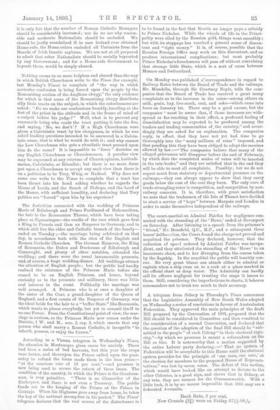The festivities connected with the wedding of Princess Marie of
Edinburgh and Prince Ferdinand of Hohenzollern, the heir to the Roumanian Throne, which have been taking place at Sigmaringen—the cradle of the race which gave first a King to Prussia and then an Emperor to Germany, and in which still live the elder and Catholic branch of the family- -ended on Tuesday ;—the marriage being celebrated on that day, in accordance both with the rites of the English and Roman Catholic Churches. The German Emperor, the King of Roumania, the Dukes and Duchesses of Edinburgh and Connaught, and plenty of other notables, attended the wedding ; and there were the usual innumerable presents, and, of course, a huge wedding-dinner. All weddings attract the attention of English people ; but the public had hardly realised the existence of the Princess Marie before she ceased to be an English Princess, and hence, beyond curiosity as to the presents and millinery, there was little real interest in the event. Politically the marriage was well arranged. A Princess who is at once a daughter of the sister of the Czar, a grand-daughter of the Queen of England, and a first cousin of the Emperor of Germany, was the ideal bride for the heir to a "buffer State" like Roumania, which wants to please everybody, but yet to commit itself to no one Power. From the Constitutional point of view, the mar- riage is curious, as the Princess Marie now comes under the Statute, 1 W. and M., sees. 2, cap. 2, which enacts that any person who shall marry a Roman Catholic, is incapable "to inherit, possess, or enjoy the Crown."


































 Previous page
Previous page